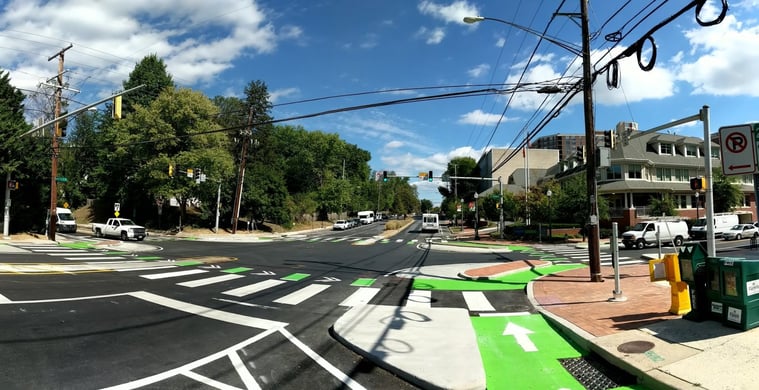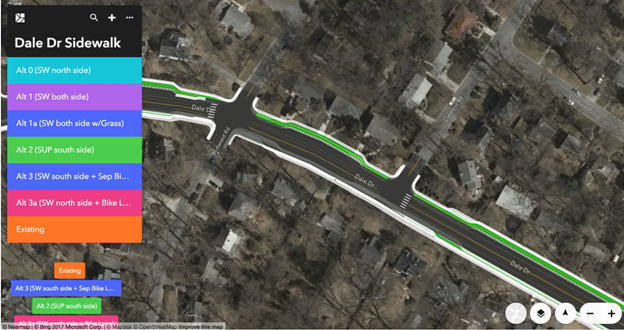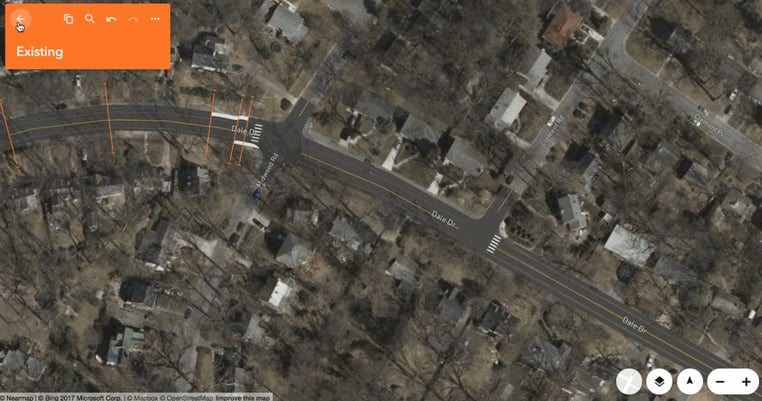About Montgomery County, MD
Montgomery County is the most populous county in the U.S. state of Maryland, located adjacent to Washington, D.C. It includes a full range of built environment types, from historic streetcar suburbs and high-density transit-oriented mixed-use hubs to traditional suburban housing and retail all the way to the rural Agricultural Reserve. The county has been ranked as one of the wealthiest in the United States. Like other inner-suburban Washington, D.C. counties, Montgomery County contains many major U.S. government offices, scientific research and learning centers, and business campuses, which provide a significant amount of revenue for the county.
Challenge
Montgomery County’s Department of Transportation was using a mix of generic and traditional tools to complete conceptual street design alternatives. This process was cumbersome, siloed, and slower than the pace they were striving for. They needed an all-in-one tool that could allow the County to deliver quickly on the early phase work for their community.
Solution
The County introduced new conceptual street design technology, powered by Remix, that enabled them to save money and staff time, accelerate project timelines, and gain valuable process efficiencies, all leading to better outcomes for the County.
Results
- An estimated $185,000 USD savings in 18 months: dollars spent before vs. dollars spent with Remix
- Accelerated project kickoff timeline by 4-6 weeks
- Increased efficiencies: 2-3 weeks time savings for every conceptual design modification
- 5 projects in progress in the first 6 months
Tell us about the initial challenges you were facing with regards to street design.
Before having new technology to support the early phase street design process for both cross section and plan views, we relied heavily on consultants for visuals. It was a time-consuming process working back and forth with consultants in a time-intensive and manual process to try to achieve the multiple alternatives quickly. We had to worry about measurable scale- sketching by hand and literally handwriting on top of a public web map in a graphic design software or desktop office software- so we could give it to the consultants for the early stage of design.
There was also a significant amount of time delay, as we waited to kickoff projects with consultants. It took time to create the task, get approval, send the task back to the consultant, and then wait for it to be returned. The total time to procure a consultant took at least 4-6 weeks. If we then needed modifications to the design, it would take an additional 2-3 weeks minimum as we waited to receive it back from the consultant.
In addition, we needed an easy way to offer shared access of designs and documents to all staff members for better alignment and improved communication internally. With a manual, undigitized process, giving all staff members visibility into projects quickly was a challenge.

Why did you select Remix as your technology partner?
We applied to join Remix’s Early Customer Program after watching a video that caught our eye on social media. We found the product to be turnkey, which was important to us. We needed a tool that allowed us to confidently train interns and new staff members on how to use it in just a couple hours, and enable them to pick it up rapidly versus traditional drafting software which requires a lot longer to learn and is a specialized skill.
In addition, having the ability to leverage and upload our very own data into Remix was a big factor. That’s huge that we don’t need to create new data sets. It’s extremely quick versus laying something out in other mapping applications for corridors. Furthermore, we recognized the Remix team as being very responsive, and we wanted a partner who was driven to continually make improvements and be responsive to our requests.
Remix is extremely quick in comparison to laying something out in other mapping and layout products for corridors. The product is really turnkey, and the ability to upload and use our own data in Remix is huge.
John “JT” Thomas
Transportation Planning Manager, Division of Transportation Engineering, Montgomery County Department of Transportation
What are some of your team’s recent wins with street design?
A big win is the ability to use Remix technology on our laptop in meetings with stakeholders through dynamic visuals that enable real-time feedback. On Executive Boulevard, we did this on the fly in a meeting with our traffic division and were able to quickly demonstrate how much space we have and the various scenarios we were proposing with a three-lane intersection. The ability to overlay turning counts on the concepts was key to understanding that we didn’t need so many lanes to move the vehicular volumes we were seeing. We all immediately could see the different challenges involved in taking away that center turn lane. It was an easy way to get a quick look at constraints, weigh tradeoffs, and ultimately gain alignment faster.

What benefits are you seeing with Remix?
We are seeing many benefits from using street design software including:
- Cost savings: We have saved an estimated $150,000 to $200,000 over 18 months using Remix technology across four samples projects: Dale Drive Sidewalk Facility Planning, Fenton Street Concept Development, Woodmont Bikeway, and the Executive Boulevard. The savings were realized from engineering costs and public engagement for each project.
- More accuracy: We don’t have to worry about measurable scale or sketching by hand anymore. The primary tools we used to use for concept work were legacy mapping, analysis and software applications. We can now immediately go into Remix for concept work instead of going to those other applications, and the measurements have been laid out. It’s so much faster and more accurate in Remix than laying it out in other technical mapping and layout applications for corridors. We can then quickly pass on the drawings for early stage of design.
- Time savings: Before Remix, it would take a minimum of 4-6 weeks just to kickoff a project with a consultant due to the back-and-forth process of needing to open a workbook order, create the task, wait for approval, send them the task, and then wait for the task to be returned. We didn’t have 4-6 weeks to wait if an ad-hoc request came in or we needed to take advantage of a resurfacing project; we needed to have the design done that same day. We have now reduced a 4-6 week timeline down to a couple hours!
- Fast design modifications: We are saving 2-3 weeks every time a design modification is needed, because we used to get held up in that process waiting for consultants to return the task to us. This has generated the ability to more easily mock up design alternatives in real-time. The time savings by eliminating back and forth process steps with consultants is a huge priority for our senior managers.
- Ease of use: The Remix platform is an easier application to use than some other options. We can easily upload our own data; no need to create new data sets. We can do things very fast in Remix; some mapping, layout and analysis applications have become slow and clunky. It’s also intuitive: we can sit down with a new hire for two hours, and they leave knowing how to use it. We even have high school interns using it with ease.
- Increased project bandwidth: We started with five active projects in the first six months of using Remix, and we continue to add more projects. Having the right tools allows us to take on more and be more efficient.
- Shared access: All staff members have access to the Remix platform which means everyone has real-time visibility into the latest designs, enabling better communication and transparency across multiple departments.
- The little things add up: There are many little things that aren’t big tasks but have a big impact. Even if we don’t have a full-blown capital project, we see small wins. For example, if a temporary detour comes up, we can quickly mockup what it would look like for bikeways on a roadway for six months while the other road is shutdown. These are the ad hoc things that come up that weren’t budgeted for consultant work, and we can use Remix to deliver.


Tell us about your partnership with the Remix team and what it’s like to work together.
We have an ideal partnership with the Remix team. They’re very responsive to our product suggestions. For example, we wanted the ability to visually distinguish between different types of lanes. We suggested it to the Remix team, and they incorporated it into the tool. It was great to see our feedback addressed. We feel like we have a seat at the table and our voices are heard as we continue to help shape the Remix platform so all public servants can benefit.
What’s next for your department as you look ahead armed with technology tools?
We’re looking forward to three new planning projects and other sidewalk/bikeway projects over the next few years. It’s exciting to be able to apply this new technology every time we have a new start; that’s a big deal. And we still haven’t tapped the usage of the Remix platform for public outreach, so we have that to explore further in the coming days.
